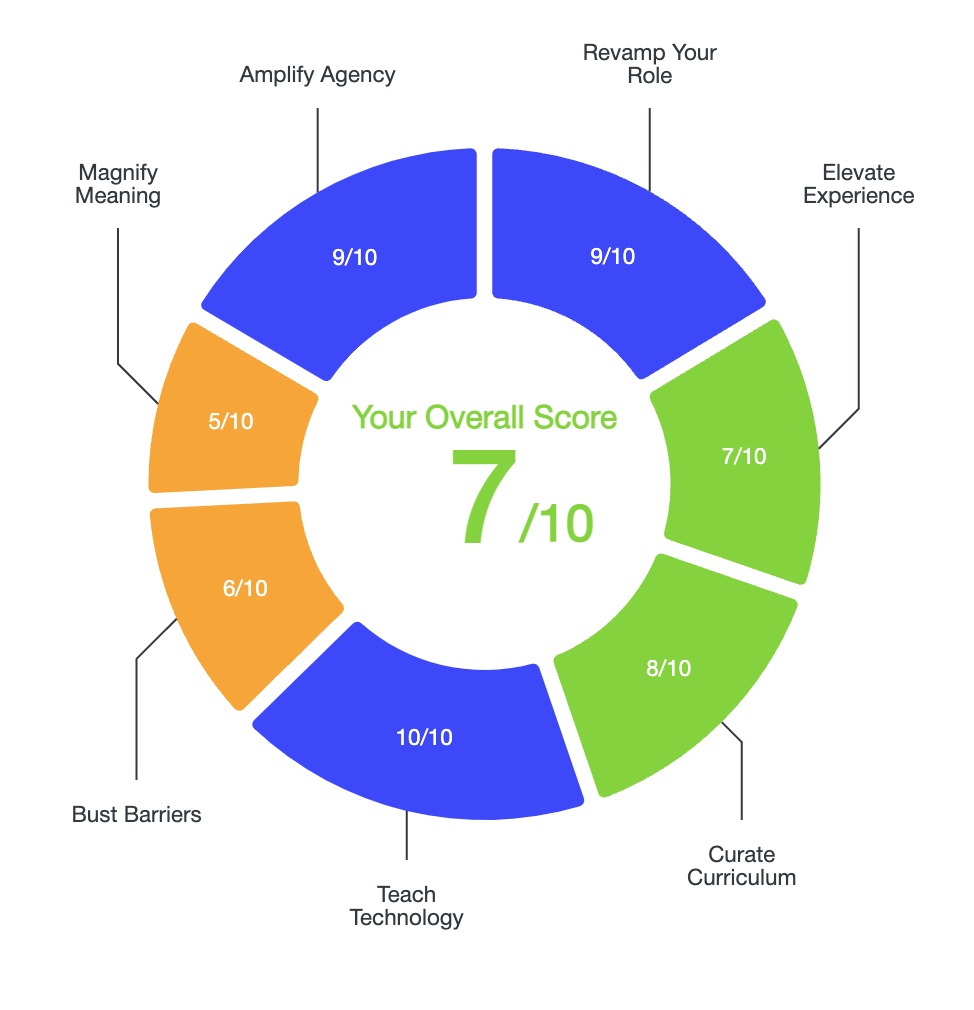As educators make the shift toward teaching with technology they will need access to programs that help make running their 21st century classrooms more efficient and effective. If you teach at a Google for Education school, Hapara fulfills that need and more, and should be a part of any G-Suite school’s instructional technology plan. Read on or watch the recording of my live show below to learn why!
This post has been sponsored by Hapara. For more information about getting a Hapara account for your school, click here. The product review and opinions expressed in this post are based solely on my personal views.

What Is Hapara and How Does It Help Teachers?
Hapara is a teacher and student workflow management system that seamlessly integrates with G-Suite apps such as Google Classroom, Drive, Docs, Sheets, and Forms, adding a layer of functionality to Google for Education tools that makes them significantly more classroom-friendly.
Hapara provides clear solutions to some of the some pressing concerns teachers face when teaching with technology:
- If you can’t see students’ computer screens, how do you know they are on task, and how can you give them targeted feedback?
- How can you make adjustments to your instruction on the fly and retain flexibility in a digital environment?
- How can you use multiple technology tools without logistical challenges bogging down and even derailing lessons?
First, one of Hapara’s primary functions is to increase overall visibility when teaching with technology.
Arguably one of the main reasons we tend to elevate the status of traditional in-person teaching over virtual learning pertains to the high level of visibility traditional instruction affords. Teachers can glance around the classroom and see what students have out on their desks, can circulate around the room and see what students are writing on their papers and provide them with in-the-moment feedback, and teachers can create environments more conducive to learning because they can see potential distractions (an assignment from another class, an unrelated book out, etc.) and ask the student to put it away.
The ripple effect of the limited visibility educators experience when teaching with technology, whether in person or remotely, is hard to understate, and it’s almost certainly a leading reason why some teachers are hesitant to fully embrace technology use in their classrooms.

If low visibility in a technology-integrated classroom is a primary concern, workflow management is a close second.
Traditional in-person classrooms rely on a wide-array of systems and structures to run efficiently: passing out papers, handing in work, procedures for taking tests, different seating arrangements for flexible groupings, just to name a few.
Teaching with technology, however, requires entirely new systems and tools in order to achieve the same outcomes. Many teachers are new to creating these systems, and lack access to the tools necessary to do so. The result is that workflow issues such as efficiently passing out digital assignments, quickly getting students on the correct webpage, ensuring students stay on the correct pages, can all become major problems that threaten to derail entire lessons.
Again, this is where Hapara steps in to help with its easy-to-use workflow management system. Let’s look at some specific ways how. ![]()
Increased Visibility with Hapara
The Hapara Teacher Dashboard gives you a bird’s eye view of all your students’ workspaces, providing you with a much higher level of centralized visibility than you have with just Google Drive or Google Classroom.
See the Status of All Assigned Documents in One Place
First, Hapara’s Teacher Dashboard allows you to clearly see all the documents you’ve assigned to students via Google Classroom on a single screen. Although the Assignment Viewer in Google Classroom allows you to see single assignments, there currently isn’t any way to see all assignments on a single screen using Google apps alone.
On the other hand, with Hapara, you can also easily see whether a student opened an assigned document, when it was last updated, as well as who last updated it.
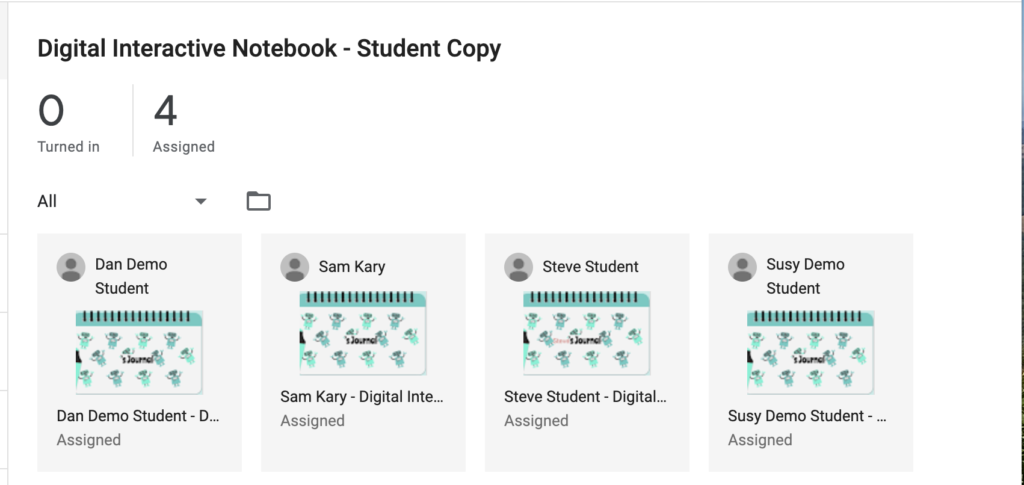
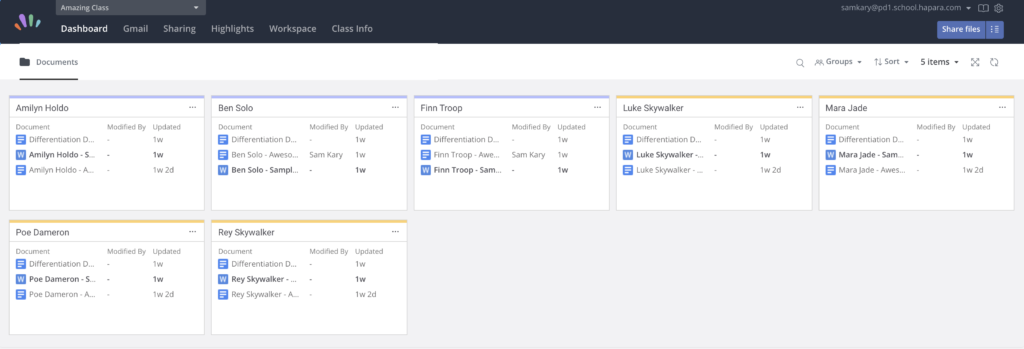
Access All Assigned Documents for Formative Feedback
In addition to seeing all the documents you’ve assigned in a one place, you can also click on each assignment in order to quickly access them. This quick access to student work gives you a clearer picture of how students are progressing with assignments and allows you to easily jump in and provide students with feedback.
You can give feedback directly on an assignment, as seen below, or send students individual messages about their work, again something you cannot do with a tool like Google Meet alone, for example. More on instant messaging in Hapara below.

Real-time Visibility with Hapara Highlights
While the Hapara Dashboard gives you greater, more consolidated visibility of the work you’ve assigned students, Hapara Highlights provides you with invaluable real-time visibility. Think of Hapara Highlights as akin to a control center, one that lends the same bigger picture understanding of everything that’s happening when students work online that we already expect in more traditional in-person classrooms. Here’s how.
The Browser Tabs feature in Highlights allows you to see all the current tabs students have open on their school-issued computers during class. Think of this as the virtual equivalent of being able to circulate around the room and see what’s on a student’s desk at any given time.

Next, the Current Screens feature in Highlights allows you to see a student’s screen in real time, a crucial element of providing students with targeted support, particularly regarding logistical issues they might be having.
I’m sure we’ve all encountered countless scenarios where students have difficulty navigating programs, and have wasted enormous amounts of precious time trying to troubleshoot issues without being able to see exactly what’s happening on their screens. The Current Screens tool helps you navigate this scenario with significantly greater ease by allowing you to give explicit instructions based on what students are currently doing on their computers.
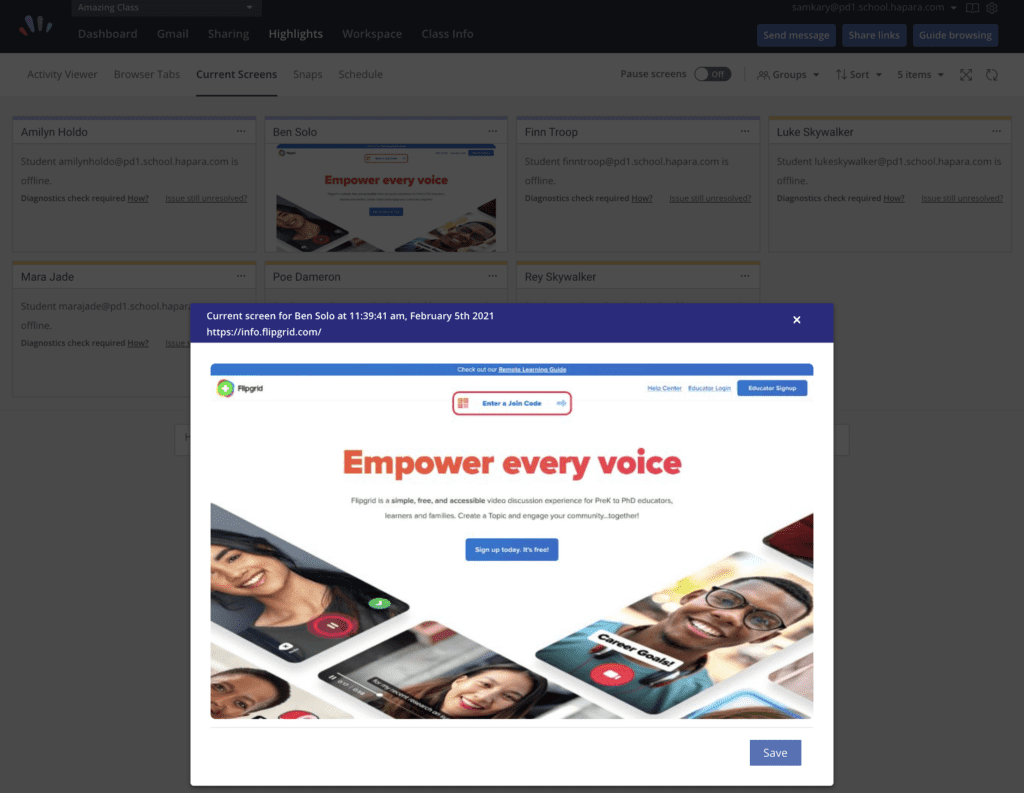
In addition to greater visibility of individual student work, the Activity Viewer in Hapara Highlights also allows you to get a holistic sense of your classes activity online. The Class Activity section helps you see how many total students have actually accessed certain websites. The Unique Activity section allows you to see websites that students have visited that other students have not.

On the Activity Viewer page you can also click on the bar graph to see exactly who has visited each page, as well as who has not. This feature helps make the process of objectively identifying which students need additional support much more efficient.
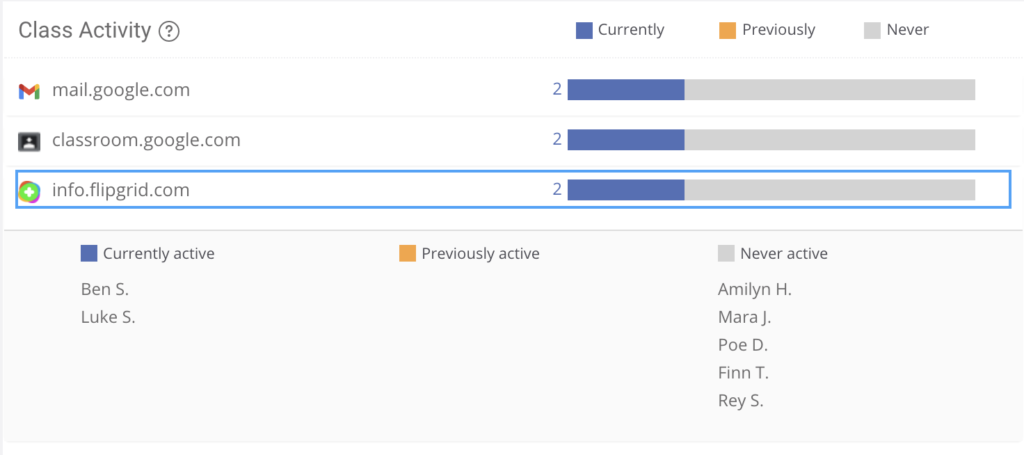
Instant Messages to Individual Students or to the Whole Class
You might have noticed on the Browser Tabs graphic above that one of the students in the class had a tab open to a webpage about Fortnite. I’m sure you’ve all had the experience of having a student take out something unrelated in class. This is the digital equivalent of that situation that, and can quickly turn in a situation that leads to greater distraction without the right tools in place.
If you notice that a student has a tab open for a website that doesn’t pertain to the work you are doing in class, you can use the Send Message tool to send them a reminder about where they need to be. Think of this as the virtual equivalent of reminding a student with an unrelated book out in class that they need to put their book away.
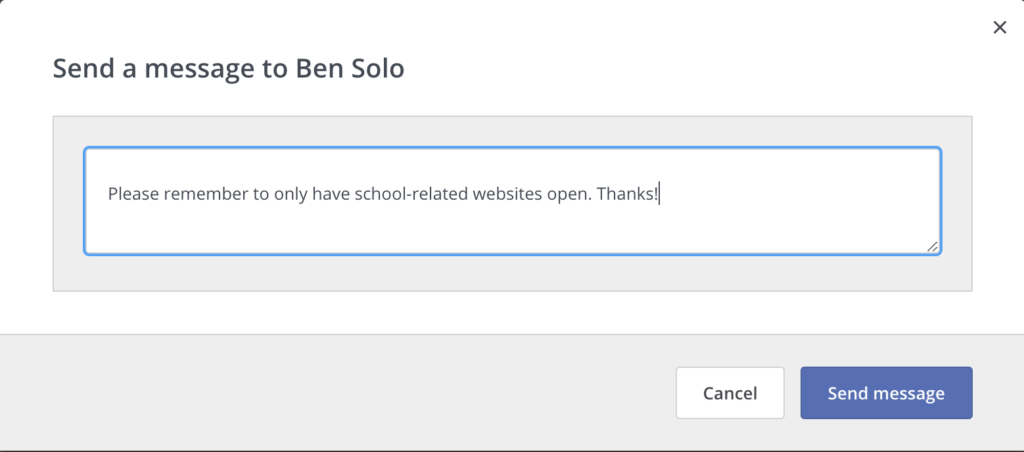
If a student doesn’t respond to your message, you can also manually close their browser tab, just like you would have a tool in your management toolkit in a traditional classroom. Like any other negative classroom management technique, proceed with caution because, as you know, you can only “withdraw money” from the positive classroom culture bank every so often.
You should only close browser tabs after providing positive reinforcement as well as giving students the opportunity to make the adjustment on their own. If you do need to take this step, you’ll be prompted to send them a message letting them know why.
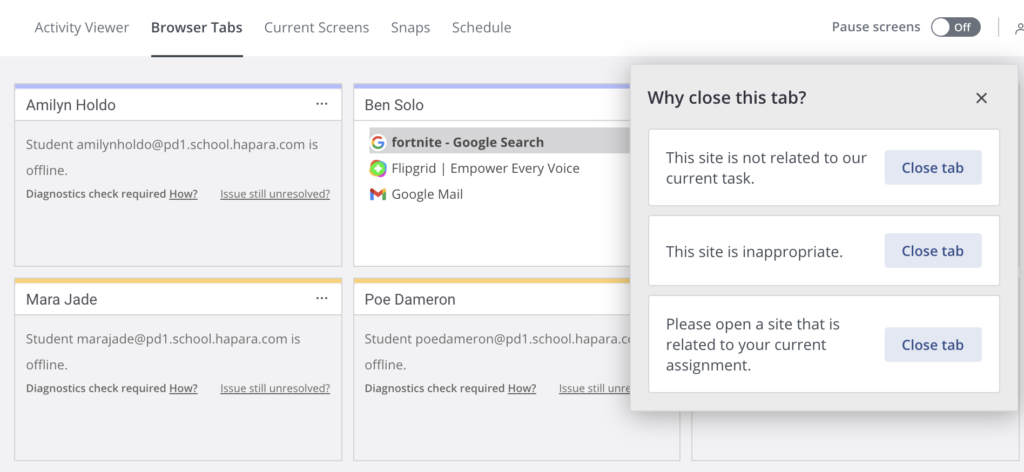
Managing Workflow with Hapara
Just as any effective teacher must have workflow systems for a traditional classroom to run efficiently – passing out papers, handing in work, procedures for quizzes, different seating arrangements, etc. – effective teaching in a technology-integrated classroom also requires high-functioning workflow systems.

“Handing Out” Digital Assignments with Hapara
Although Google for Education apps have many useful features, workflow management in G-Suite can still be a challenge.
Consider a simple, daily activity such as passing out physical pieces of paper in a classroom. Choosing when, how, and to whom to pass papers in class is part of the way a teacher orchestrates in-class workflow.
Regardless of whether you teach in person or online, handing out digital “papers” can be clunky. Assigning work through Google Classroom will get the job done, but it’s not a very efficient way to “pass out” virtual handouts as opposed to assignments because it requires teachers to set up the assignment ahead of time and then relies on students opening Google Classroom and finding that assignment on their own.
Hapara’s Smart Share feature entirely eliminates this headache.

Just as you would with physical papers, Hapara allows you to pass out digital assignments with the Smart Share feature in the Teacher Dashboard.
With Smart Share, you can select files from your Drive to share with your entire class or with selected groups of students (more on this below). The default setting is to make a copy of the assignment for each student, but you can also choose to share a single view-only, comment-only, or editable file. Rather than ask 30 individual students to go to Google Classroom to find assignments during class (a guaranteed time-killer), Smart Share relies on one person: you.
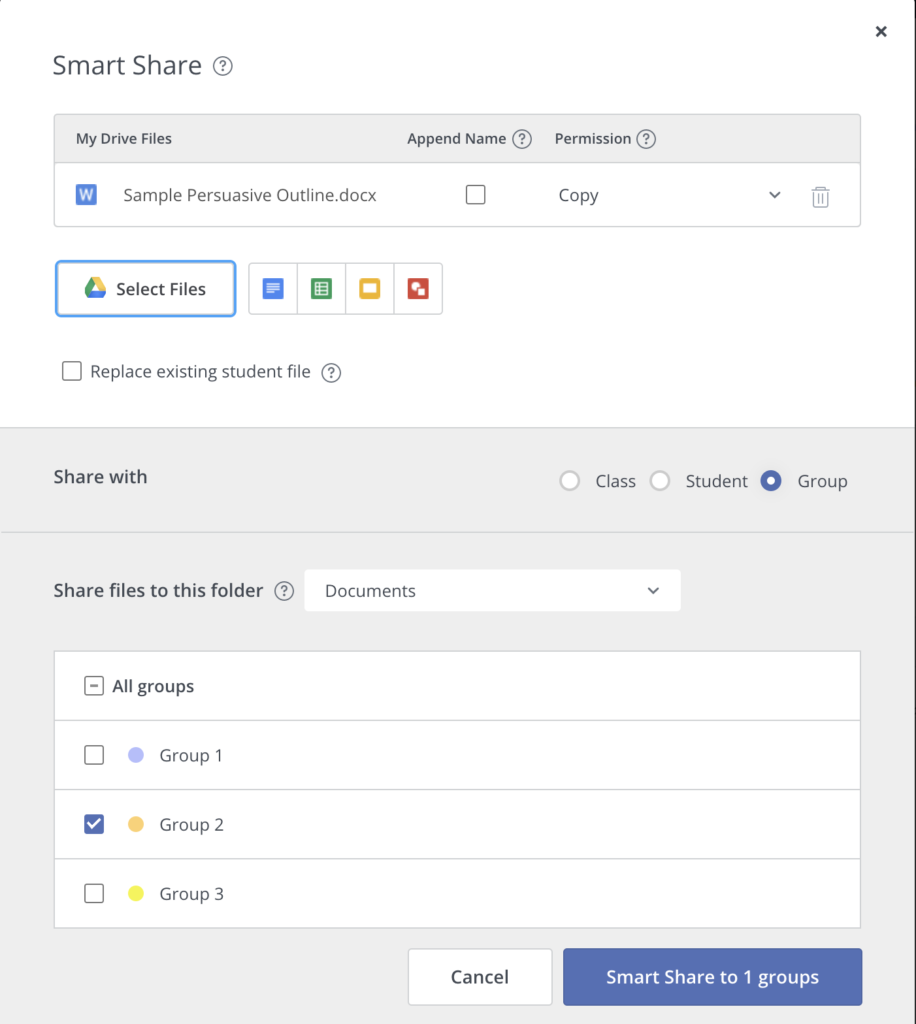
Differentiated Document Sharing
As mentioned above, the Smart Share function allows you to share files with select groups of students as opposed to the entire class. You can easily set up groups in Hapara by selecting “Groups,” clicking “New Group,” and then selecting the students you want to add to that group.
Easily reconfiguring student groupings with a couple of clicks makes it incredibly simple to differentiate the assignments you share with students. If, for example, you have a scaffolded version of an essay outline with sentence starters, you can set up a group and selectively pass the document out to them with ease.

Instantly Share Website Links with Students
In addition to sharing digital assignments with students, Hapara also gives teachers the ability to push website links directly to student browsers with its Share Links feature.
Similar to the challenge of getting digital documents to students in a quick and easy manner, getting all students to the same website can take up time and gum up lessons.
Hapara’s Share Links tool allows you to simply copy and paste a website url and push that url link out to students as a separate tab with just a couple of clicks, helping you teach in a fluid, evenly-paced way that doesn’t rely solely on individual students navigating to web pages on their own.
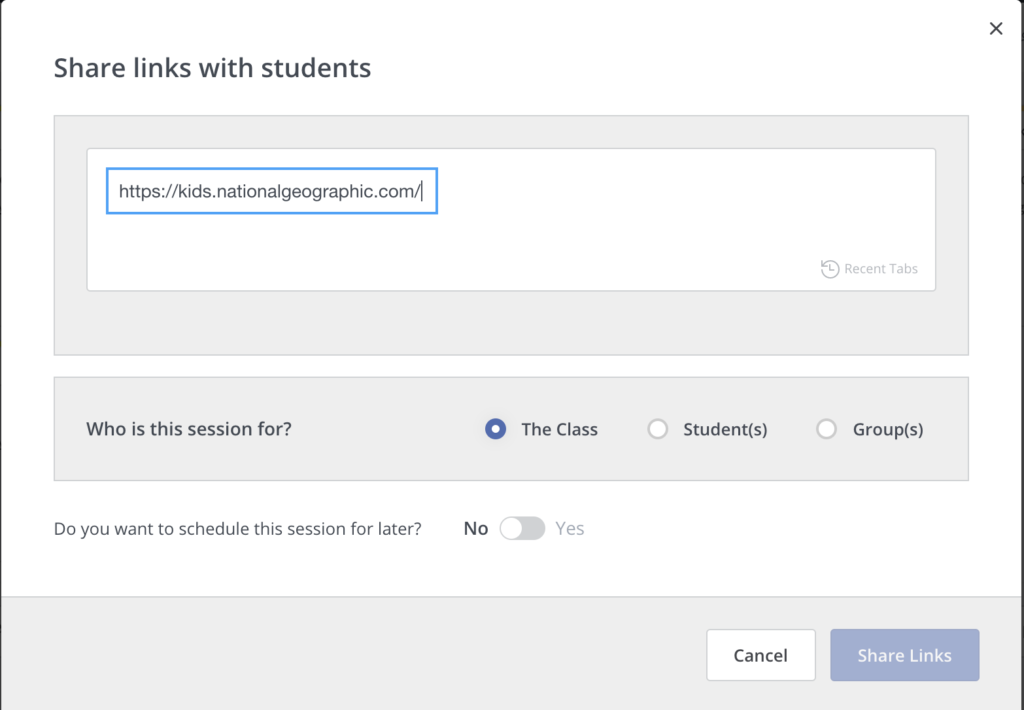
Set Up Focused Browsing Sessions
Another highly useful Hapara feature is the ability to create Focused Browsing sessions. The Focus Browsing tool allows teachers to essentially freeze webpages on student computers for a given period of time.
This has obvious benefits for assessment purposes, and when used selectively and in agreement with a student, can also help students stay focused on a particular task if needed. Focused browsing sessions can be set up ahead of time, or done on the spot. And just like every other Hapara feature, focused sessions can apply to the whole class, groups of students, or individuals.
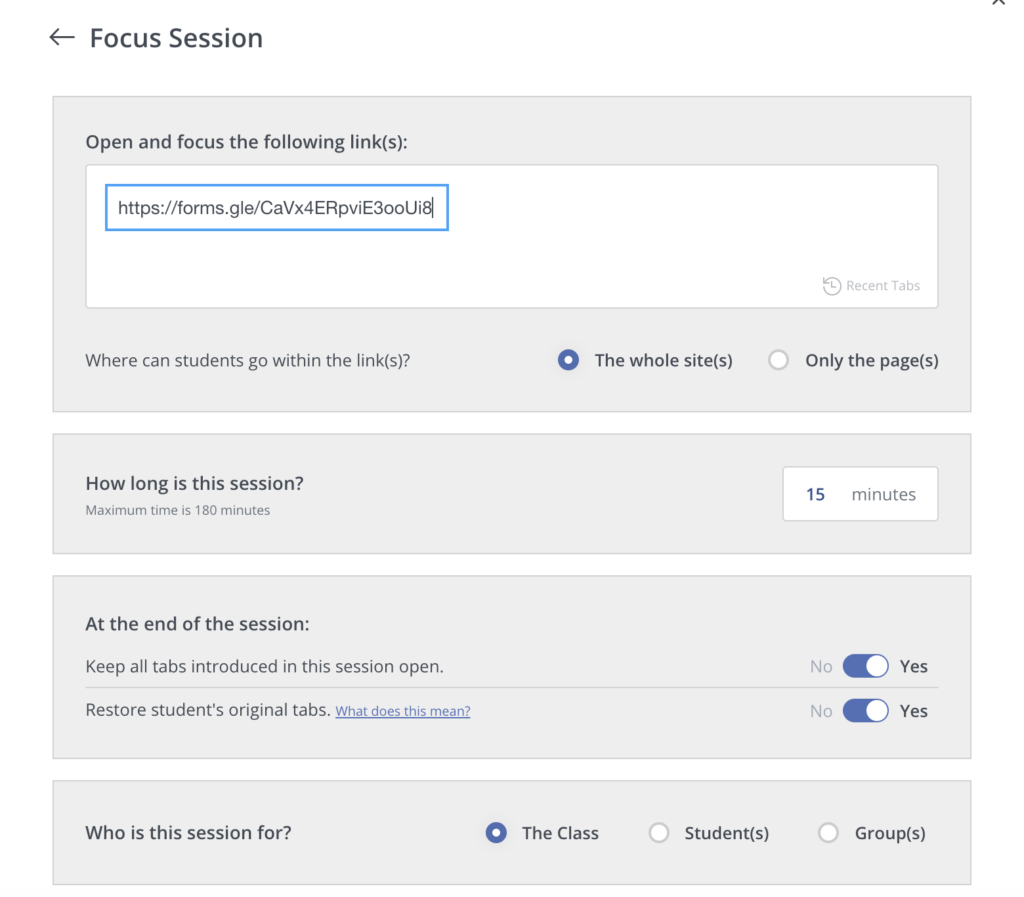
Conclusion
It’s clear that as schools shift educational practices online, teachers will need the right tools and strategies to effectively facilitate technology-integrated classes. From personal experience, I can attest to the fact that this remains true irrespective of whether you are teaching in person or online.
This post covered many of the ways in which Hapara supports teachers by providing a higher degree of visibility as well as managing teacher and student workflow. But there’s still even more ways Hapara can help. Stay tuned for a future post about the Hapara Student Dashboard, which helps students manage their own workflows as well, as well as Hapara Workspaces, which allows you to set up fully customized virtual classes.
Lastly, if you’re interested in bringing Hapara to your G-Suite school, be sure to click on this link to learn more!
For additional strategies for how to use technology to personalize learning, increase engagement, foster creativity, and more, click here:
How to Use Education Technology: The Ultimate Guide
And to read more about why I believe technology must be a central part of public education today, click here:
Why Education Technology?: The Ultimate Guide
Interested in the software I use to create my videos? Check out the links below! Many of these products offer a free trial to start and just clicking on the link helps to support The New EdTech Classroom!
Screenflow is a dynamic, intuitive video editing software that I use to create all of my YouTube videos. They’re currently offering a free trial! Get more details here.
I use Adobe Spark Post to design all of my YouTube thumbnails, as well as all my social media graphics. More information here.
If you’re interested in creating a website, these are a couple of programs I personally use and highly recommend: Bluehost is a web host that offers a professional platform for your website. You can check them out here.
Elementor is a powerful tool that helps with clean visual design for your website as well as marketing to further your website’s influence. More details here.

